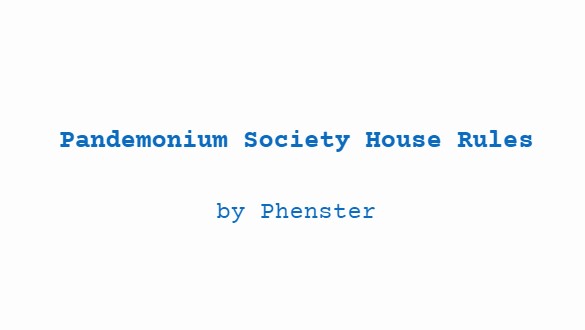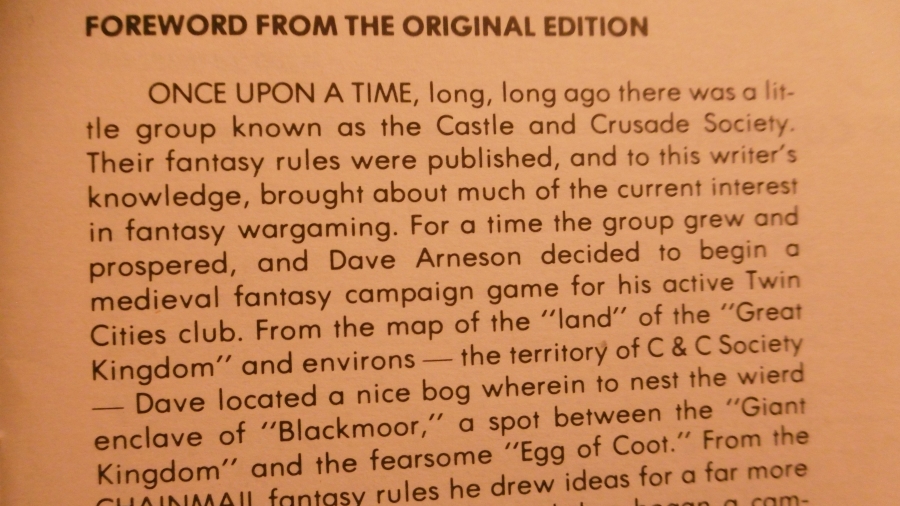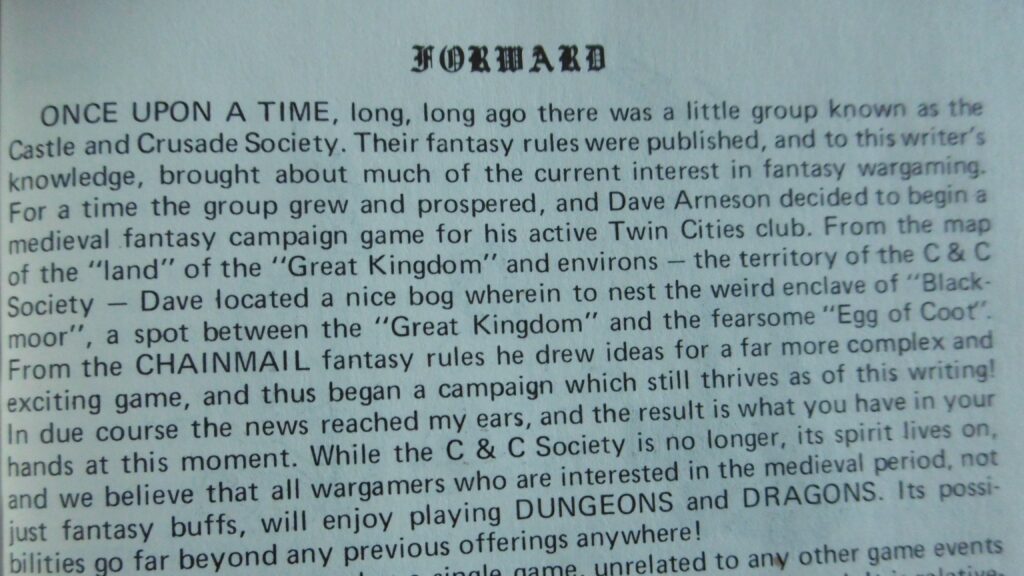Wherefore Deep Dark Dangerous Dungeon Delves
The following text is from L’avant garde, the Newsletter of the East Middleton Wargamers Association, #69 (November 1984).
Wherefore Deep Dark Dangerous Dungeon Delves
We love to go into the dungeon searching for treasure. You might think that's not very sophisticated. That's what the big kids at the Game Hoard say sometimes. But the dungeon is full of ancient gold coins that shine in the torchlight. Strange icons and busts of dead kings are stamped on their faces. Sparkling gems--yellow amethysts, red rubies, green emeralds, blue sapphires and white diamonds--fill silver coffers inlaid with ivory. Glass vials filled with liquids of bizarre colors. Tattered parchments rolled up and tied with an old leather thong. Swords with jewel-encrusted hilts sticking out of their scabbards. Mysterious runes on the blades glow softly in the dark.
Finding treasure is fun! How we find it is just as much fun. We hardly ever just open a door into a room with a big hoard of coins and jewelery and magic stuff and the dragon out getting its internal fires rekindled. It's more like we discover a cubbyhole behind a loose stone and find an old rotten bag with a few silvers and maybe a couple tiger eyes and a poisonous spider too! Sometimes, we'll find something like an old ceramic jar with runes scratched around the middle and filled to the brim with gold pieces. As soon as we touch the gold, the runes explode and we have to scoop coins and body parts off the floor. Once, we found a chest full of treasure, but it was on the other side of a bottomless pit!
We usually go into the dungeon looking for treasure. But there's always something happening down there that makes us want to go back. Like, we were on a quest for a magic wand one time, and we found a river running through a chasm that ran through the dungeon. After we got the magic wand, Tombs wanted to go to the end of the chasm, just to see what was there. We found a cyclops guarding a giant wheel of cheese and a magic boat that went upstream!
Once, I only needed 400 more XP to get to 6th level. We were a big party that day, so we had to get at least 4,000. A nice treasure hoard would've done it, but we kept running into wandering monsters. Wandering monsters don't have any treasure of course. So we avoided a chimera and a displacer beast. But we had to fight a band of marauding trolls. That almost cost us. But we got the XP we needed.
By the time we'd got all the treasure out of the upper Great Halls, we heard there was a gateway to Hell down in the lower dungeons somewhere and it had been closed for a long time. We wanted to make sure nobody opened it, so we went looking for it. Somebody else found it before we did though and, sure enough, they opened it. Then we knew we'd have to go down and close it back again. Meanwhile, more monsters moved back into the upper levels and brought more treasure with them!
It's best to have a patron if you can find one. A patron pays you to go into the dungeon to do something. So you get paid, plus you get to keep all the treasure you find along the way. We have a mysterious patron named Angharad Called the Fane. She lives alone in a treehouse in the middle of a vast swamp, and she seems to have been there forever. She sometimes summons us to do weird things for her. We're pretty sure she's on our side (against the demons), but she works in strange ways. Sometimes we wonder.
Fantastic Materials
Adamant: A rare substance that acts like an unbreakable metal or a stone harder than diamonds. You can make weapons, armor, shields, helmets, chains and manacles and all kinds of tools with it. It also comes in gemstones that decorate the most ornate crowns. Adamant can also be used in construction work. For example, the Gates of Pandemonium are made out of it. We saw it with our own eyes, and we've heard that Pandemonium itself is built on a foundation of adamant.
Mithril: Stronger than steel but lighter. It's used to make magic armor that doesn't slow you down. The most valuable jewelry we ever found was made of mithril. Elves use it for their finest works of armor, jewelry and architecture.
Treasure Maps
We find a lot of treasure maps in the Great Halls. Hazard follows the rule that says 25% of the maps or magic in a treasure hoard are maps. That's a lot of maps! I cut it down to 10% in my campaign. Basel rolls a d12, and a 1 makes it a map.
When we roll a treasure map, we roll d12s to find out what it leads to. Then we have to make the map. That's the hard part. I used to just copy part of my dungeon map and put an X on the treasure location. Now I mix it up with directions written out on a scroll or poems and riddles. Basel puts his treasure on a wilderness map. One time, he made an big fancy treasure hunt out of a map to the Sword of the Golden Bough King. Took us weeks of playing, and we never did find the sword.
Hazard has the best ideas though. Sometimes he uses a regular dungeon map, but then he'll throw in a really interesting "map," like a magic mouth that tells us how to find the treasure. One time we found directions scratched on a wall next to a skeleton with a dagger in its hand and an arrow in its ribcage. Then there was a crystal ball that showed the places we should go through to get to the treasure. But it only showed them one at a time.
Once, Mithrellas picked up a gold filigree jewelry box out of a pile of silver pieces. It was trapped with a sleeping gas. So when she opened it, she fell asleep on the silver pile. She had a dream where she wandered through a forest in a series of lefts and rights, until she got to a pool of calm, clear water. At the bottom of the pool, she saw a hoard of glittering treasure. After we woke her up, we went through the dungeon, following the same series of lefts and rights Mithrellas took in her dream forest. At the end, we found a pool with a hoard of glittering treasure and a green dragon!
When you get a treasure map, roll a d12 on the Map Find table, then a d12 on one (or both!) of the Treasure and Magic Items tables.
| d12 | Map Find |
|---|---|
| 1-6 | Treasure |
| 7-10 | Magic |
| 11-12 | Treasure & Magic |
Treasure
The g.p. amount on the table is the VALUE of the treasure, not necessarily a bunch of coins. It could be lots of kinds of stuff, like works of art, paintings, statuettes, tapestries, books, etc. If you roll a 1-5, then that's the number (n) of d6s you roll for g.p.
| d12 | Treasure |
|---|---|
| 1-5 | nd6 x 1,000 g.p. |
| 6 | 1d6 x 1,000 g.p. + 1-20 gems |
| 7 | 2d6 x 1,000 g.p. + 1d6 jewelry |
| 8 | 3d6 x 1,000 g.p. + 2-40 gems |
| 9 | 4d6 x 1,000 g.p. + 1-100 gems |
| 10 | 5d6 x 1,000 g.p. + 1d10 jewelry |
| 11 | d6 x 10 gems + 2d10 jewelry |
| 12 | 5d6 x 1,000 g.p. + d12 x 10 gems + 2d10 jewelry |
Magic Items
| d12 | Magic Items |
|---|---|
| 1 | Any 1 |
| 2 | Any 2 |
| 3 | Any 3 |
| 4 | Any 3 + 1 potion |
| 5 | Any 3 + 1 potion + 1 scroll |
| 6 | Any 4 |
| 7 | Any 4 + 1 scroll |
| 8 | Any 4 + 1 potion + 1 scroll |
| 9 | Any 5 |
| 10 | Any 5 + 1 potion |
| 11 | Any 5 + 1 scroll |
| 12 | Any 5 + 1 potion + 1 scroll |
Exceptional Value of Gems/Jewelry
When we find gems and jewelry in the dungeon, Hazard lets us roll to see if it has exceptional value (when we get it appraised).
Gems: A 1 on the d6 means the gem is the next higher value and roll again until you don't get a 1. If you get a 1 at the highest value, double it.
Jewelry: On dungeon level 4 or deeper, a 1 on a d6 means the jewelry is 10 times more valuable. On level 8 or deeper, roll the d6 like for level 4, then, a 1 on a second roll means double the value. On level 13 or deeper, a 1 on the second roll means times 10 again (total 100 x more valuable, that's 3d6 x 10,000).
Pale Electrum
Electrum coins are usually made from a mixture (alloy) of gold and silver. But sometimes they're made from gold and platinum. We call that pale coin (or pale electrum vs. yellow electrum). 1 pale electrum is worth 2 g.p. Me and Hazard use 1/6th chance for pale electrum in our campaigns. Basel uses 50%!
Coin of the Realm
We like to give names to different denominations of coins. So instead of just "gold pieces," we pay for equipment with gold "crowns" in the Heptarchy, and we tip the taverner at the Nine of Pentacles with a few platinum "thrones" (because he makes sure we get lucrative rumors). Like that, it makes the world seem more real.
The names are different for every world. They usually have something to do with the theme of the campaign. In King of Wands, Basel uses gold "kings" and silver "barons." There are lots of dragons in Avendyr, so we have silver drakes, gold dragons and platinum wyrms. But we find all kinds of coins in the dungeon, and most of them are old or ancient. We have to change the old coins for crowns at the money changer's. He takes 10%! Whatever names they used to be called are usually forgotten, so adventurers have their own lingo. For gold pieces of any mint, we usually say "rounds," but the official word is "standards" and sometimes we call them "heroes." Platinum coins are either dragons or villains, depending on the campaign. (In the Heptarchy it's dragons, but it's villains in Avendyr.) Copper pieces are "dungeon marks," because they're really only good for leaving a trail behind, like bread crumbs, to find your way back out of the dungeon.
Nomenclature of Coins
| Campaign | Great Halls (dungeons) | King of Wands | Heptarchy | Avendyr |
|---|---|---|---|---|
| Platinum | dragons or villains | wizards | royals or thrones | wyrms |
| Gold | standards or heroes | kings | crowns | dragons |
| Electrum* | lanterns/ dames | dukes/ queens | vassals/ overcrowns | yellow eyes/ pale eyes |
| Silver | keys | barons | nobles or traders | drakes |
| Copper | dungeon marks | lords | picayunes or pennies | scales or wyrmlings |
| *Yellow/Pale | ||||
This is the 36th in a continuing series of articles, which reedits house rules for Holmes Basic D&D from 40-year-old game club newsletters. Mentions of house rules are in bold text and followed by a [bracketed category designator].
For rules category descriptions and more about the newsletters, see “About the Reedition of Phenster’s.” For an index of articles, see Coming Up in “Pandemonium Society House Rules.”
Phenster’s Pandemonium Society House Rules is a work of fiction. Names, characters, businesses, events, incidents, and newsletters are either products of the author’s imagination or are used in a fictitious manner. Any resemblance to actual persons, living or dead, or actual events is pure coincidence.

The 1977 edition of Gygax and Arneson’s DUNGEONS & DRAGONS is also known as “Holmes Basic” after editor Dr. J. Eric Holmes.


